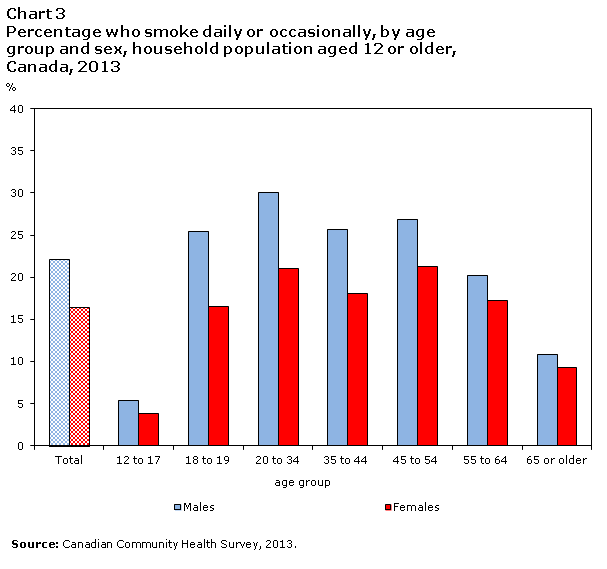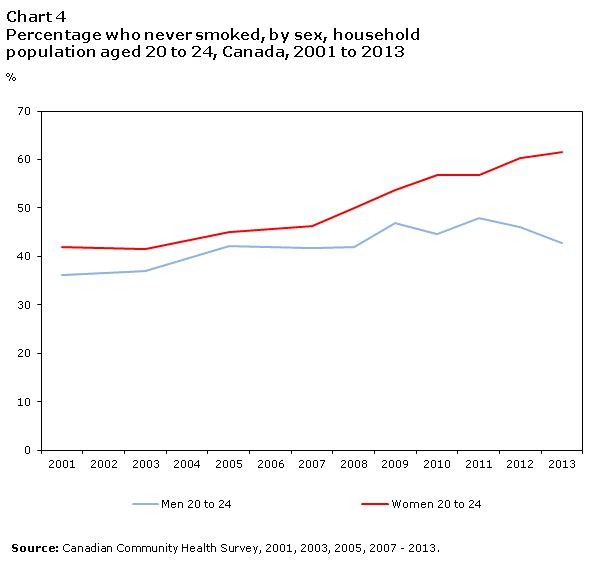Smoking, 2013
Archived Content
Information identified as archived is provided for reference, research or recordkeeping purposes. It is not subject to the Government of Canada Web Standards and has not been altered or updated since it was archived. Please "contact us" to request a format other than those available.

Smoking is a risk factor for lung cancer, heart disease, stroke, chronic respiratory disease, and other conditions.Note 1 According to the World Health Organization, smoking is an important and preventable cause of death.Note 2
In 2013, 19.3% of Canadians aged 12 and older, roughly 5.7 million people, smoked either daily or occasionally— 22.1% of males and 16.5% of females. The rates of smoking in 2013 are about the same as in 2012, but are significantly lower than in 2008. For males, the rate in 2008 was 24.3%, and for females the rate was 18.5% (Chart 1).

Of the 5.7 million smokers in 2013, the majority, nearly 4.3 million, smoked cigarettes on a daily basis. Daily smokers can be classified as heavy, moderate or light smokers based on how many cigarettes they smoke per dayNote 3. Light smokers were the most common type of daily smoker (54.2%) followed by moderate (27.7%) and then heavy smokers (18.1%; Chart 2). In 2013, males were more likely to be heavy or moderate smokers while females were more likely to be light smokers.

The percentage of daily or occasional smokers was the lowest for youths aged 12-17 (4.6%) and seniors aged 65 and older (10.0%). In these age groups, there was no difference between the sexes. Between the ages of 18 and 64, males were more likely than females to smoke either daily or occasionally (Chart 3).
Although the lowest smoking rates were at both ends of the age spectrum (chart 3), the types of smokers were different. Seniors (aged 65 and over) were more likely to smoke daily (85.3%) compared to youth aged 12 to 17 (45.5%). Non-smokers in these age groups were different as well: 61.8% of senior non-smokers were actually former smokers, compared with 6.9% of non-smokers aged 12 to 17.

People typically begin smoking during their teenage yearsNote 4, so the percentage of Canadians who have not started smoking by age 20 is an indicator of future smoking rates. In 2013, 51.8% of Canadians aged 20 to 24 had never smoked, unchanged since 2010, though an increase from 45.8% in 2008.
In the 20 to 24 age group, the rate for never smoking was higher for females (61.6%) than for males (42.8%) in 2013. The rate has been significantly higher for females most years since 2001, with the exception of 2005 and 2007 when the rates were about the same as for males. The rates for both sexes for those who have never smoked were significant increases from 2001 when the rate was 41.9% for females and 36.2% for males (Chart 4).

The percentage of residents who smoked daily or occasionally was lower than the national average (19.3%) in:
- Ontario (18.1%)
- British Columbia (16.2%)
The percentage of residents who smoked daily or occasionally was higher than the national average in:
- New Brunswick (21.8%)
- Quebec (21.4%)
- Saskatchewan (22.8%)
- Yukon (25.9%)
- Northwest Territories (33.2%)
- Nunavut (59.0%)
Residents of the other provinces reported rates that were about the same as the national average.
End notes
References
Shields, Margot. 2007. “Smoking bans: Influence on smoking prevalence.” Health Reports. Vol. 18, no. 3. August. Statistics Canada Catalogue no. 82-003. p. 9–24. http://www.statcan.gc.ca/pub/82-003x/2006008/article/smoking-tabac/10306-eng.pdf (accessed May 11, 2010).
Shields, Margot. 2005. “The journey to quitting smoking.” Health Reports. Vol. 16, no. 3. May. Statistics Canada Catalogue no. 82-003. p.19–36. http://www.statcan.gc.ca/studies-etudes/82-003/archive/2005/7839-eng.pdf (accessed May 11, 2010).
Shields, Margot. 2005. “Youth smoking.” Health Reports. Vol.16, no. 3. May. Statistics Canada Catalogue no. 82-003. p. 53–57. http://www.statcan.gc.ca/studies-etudes/82-003/archive/2005/7840-eng.pdf (accessed May 11, 2010).
World Health Organization. 2008. WHO Report on the Global Tobacco Epidemic, 2008: The MPOWER Package. Geneva.
Data
Additional data from the Canadian Community Health Survey are available from CANSIM table 105–0501.
- Date modified:
